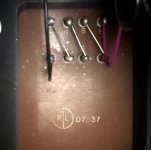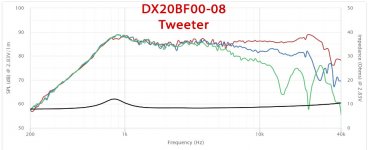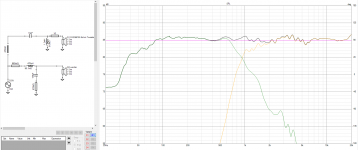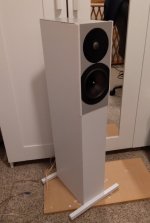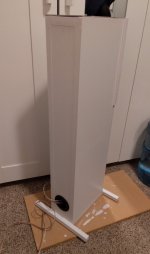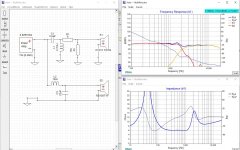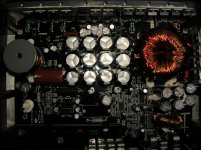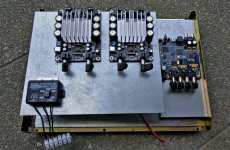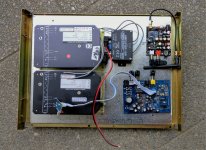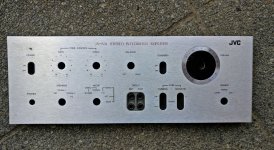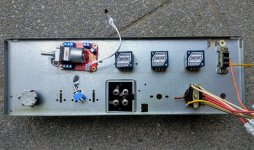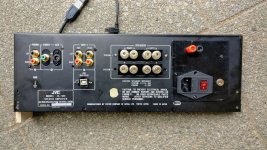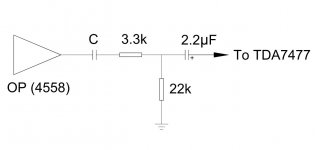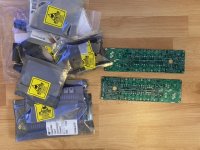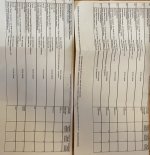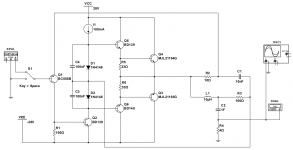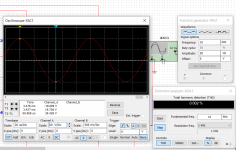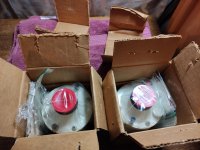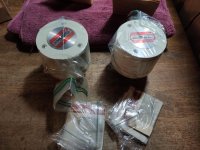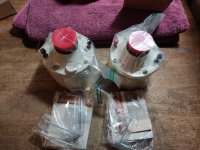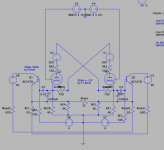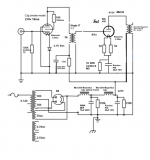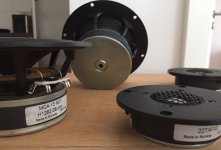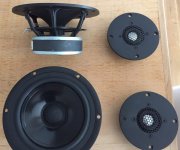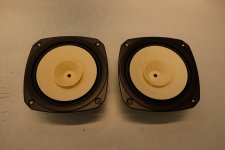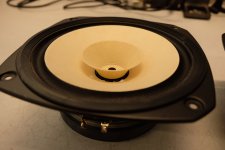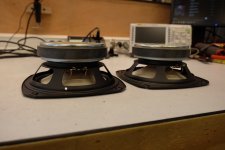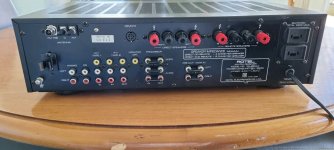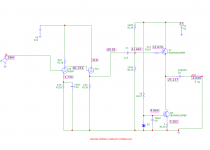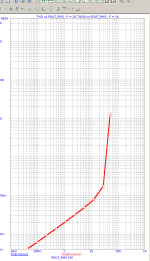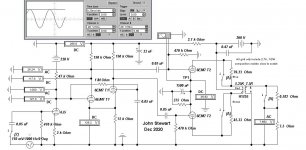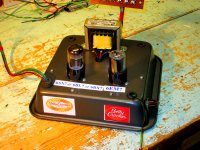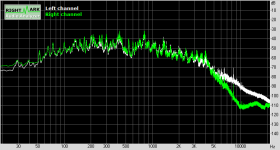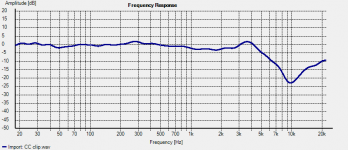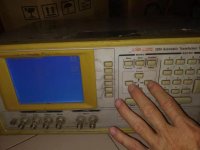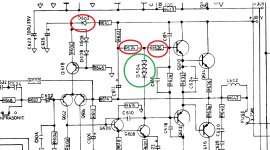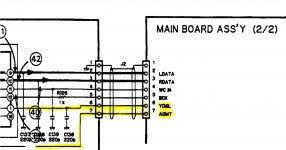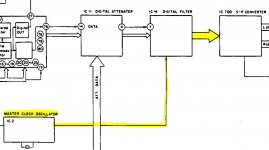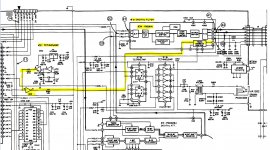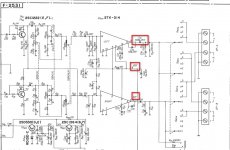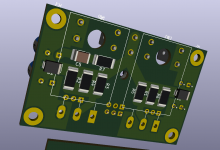1) The Design Concept.
A power amplifier design that is value for money and able to defeat the competition at four times its price.
To use if possible the SECA designs we have used in the past with more power output but less material waste in large heatsinks and huge energy demands.
The design was if possible to have a fast rise and fall time to cope with the demands of frequency to frequency phase changes.
It must also be able to go in standby mode if the users forget to switch OFF but be able to restart at the pre-set level on the input, in this design it is set to the equivalent of 1W into 8Ω.
It must have balance and un-balance inputs.
With the digital noise on the main power lines it must be able to ignore them.
It has to be over engineered in the safety area, such as the main power inputs.
The protection device to protect speakers must be fool proof.
The whole design must be based on K.I.S.S.
2) The Specifications.
Dual Mono Design one channel only shown, right or left.
Power output 8Ω @ 45W RMS , 4Ω @ 90W RMS, 150W peak into 2Ω
Maximum Peak Current 1mS 50Amps
Maximum Short Circuit for fuse to blow 6A RMS
Maximum Allowed Heatsink Temperature 40C
Input Sensitivity Un Balance 0.7V RMS into 22KΩ
Input Sensitivity Balance 1V RMS into 600Ω
Full Power Bandwidth 0.0dB flat 10Hz – 100KHz
Full Power Bandwidth -1dB flat 1Hz – 130KHz
Phase Angle change 100Hz – 20KHz less than 1Deg
Driver SECA stage A Class Power 1W
Output Device each channel six with very high speed and matched HFE drivers.
DC offset less than 1mV (typically 100µV)
3) The Block Diagram
The power inlet socket is a PCB mounted IEC with a built in fuse holder.
The Earth connection is to the chassis of the M40.
Live and Return are connected to a isolating power switch which in turn is connected to the mother board FR4 PCB.
Please note the slots in the PCB near and around the mains input live and return this is to provide extra safety precautions and to exceed the current regulations required for consumer products. Then we connect to yet a non serviceable fuse holder and fuse, this is help prevent customer tampering and increase the safety margin.
On the block diagram we show the POWER ON CIRCUIT this operates the start 16A relay with a Snubber Circuit around the relay contact to eliminate sparks and interference when operating. On Standby this circuit consumes less than 1W and in operation only 0.5W of the total power consumption. This block also has the two regulated power supplies for the RERERENCE VOLTS AND SENSE & TRIGGER CIRCUITS. These supply two ±V (V1+,V2+,OV1,OV2,REF V,V1-,V2-) and the 1.24V Reference voltages.
The TRIGGER POWER CONTROL section has two comparators which detect the input voltage on the power amp inputs and switch the POWER CIRCUIT on. The switch shown can be used to set the state the users needs, the QUICK ON SWITCH allows forced trigger to activate the power on timer of about 60 seconds this will turn off after this time if no signal is detected. The ON switch force the M40 to stay on in a continues state and the OFF switch keeps the amp deactivated and it will not trigger on.
The INRUSH LIMIT is to prevent the inrush current at peak mains from distressing the rectifiers and transformer. A note here all the main Bulk Capacitor are rated at a high ripple current, All other capacitors are designed to run in a temperature range of -40C to a max of 105C.
EMC & RFI FILTER’s 1&2 are rated at 4Amps each and are in common mode format.
The main power transformer is rated at 250VA with 8 output windings of 24VAC. These outputs winding are configured by the FULL BRIDGE RECTIFIERS to be out of phase, this allow the B/H curve to be used more efficiently when both channel need to draw a large current thus reducing saturation of the transformer.
The transformer is dipped and vacuum impregnated with a high temperature potting compound to reduce noise and provide more electrical insulation and thermal conduction.
Also wound with a µMetal magnetic shield and a Electrostatic shield to reduce the RFI and EMC emissions.
So the total noise RFI and EMC radiated and detected by the M40 is very low an increasing the quality of the music you hear without the garbage generated by our digital world.
4) The Amplifier modules.
The two amplifier modules are the same circuits to each other but careful layout of tracks help to balance their performance. These two PCB fit either side of the mother board on heatsinks.
The input has a DC blocking polycarbonate capacitor and a input impedance of 22KΩ, fitted with a small capacitor which roles the input frequency to -3dB at 14MHz, this may seem high but it allow us to have very fast rise a fall times on edges.
The next stage is a Long Tailed Pair which drive the PNP SECA drive stage controlled with a constant current, This stage is running about 1W, the DC offset is also controlled in the first stages reducing the DC to as low as 1mV (normally less)
This is simple KISS design but with very selective components, the driver and front end circuit are provided power from two (±) hum busting regulated power supplies located on the mother board. Each module has its own separate set of power supplies and there for is dual mono.
The next stages are complimentary drives, these high frequency device are normally used in radio circuit and have a high HFE for power devices, theses six transistors are forced to current share in the base drive and collector to emitter current, the HFE are match to within 1% of each set of six.
There is also another high frequency device mounted to the main heatsinks this in conjunction with a NTC monitor the inside chassis temperature and the heatsinks temperature and control the bias current in the six output power complementary power devices.
The six power devices are also HFE matched to within 1% of each set. The total IQ (quiescent current) is 1A running the power stages longer into Class A then into A/B.
Each device is rated at 150W PD and at a max current of 25A so we have plenty of head room.
There is no frequency compensation in the negative feedback circuit so very little phase change occurs.
On the mother board we have put timed independent speaker anti plop circuits this may cause one channel to turn on before the other, They are provide power by the main PSU after the fuses so if a fuse goes the speaker are never connected to the amp, keeping the safe.
The Balance circuit is done with a instrument amplifier circuit design to convert balance to no balance, This and the Balance input is controlled by a pair of signal relays operated by a toggle switch. Both can have connection at once from different sources and the selected by this switch.
The Balance inputs are set for the standard 600Ω but can be configured for any load up to 47KΩ on request.
Nearly all the components a precision surface mounted devices, resistor are low noise type and are normally under 10KΩ as this is the point noise rises dramatically in resistors.
All except a few power type are all 0.1% and the others are 1%.
The SMD power resistor are design in the rare case of a fault to desolder and drop off and not burn as we use low temperature Ag (silver) based solder. This also disconnects the faulty part of the amp from the rest of the amp.
So please enjoy you amplifier.
Kind regards and thanks.
Colin J. Wonfor
10/9/2021
Block diagram here, and yes you have to sign up but free
Oops, there was an error! | SECA